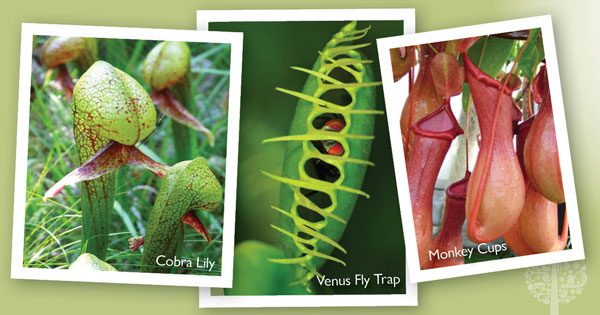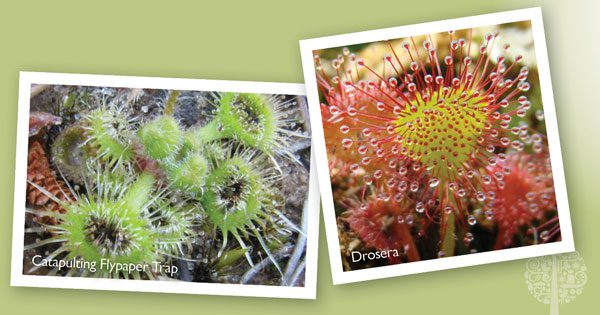Most plants subscribe to Gandhi’s belief in non-violence and are very happy with just the sun, water, and the soil’s nutrients. However, many plants are more aggressive towards living things. And while these carnivorous plants (unlike Audrey II from the classic musical Little Shop of Horrors) are no danger to humans, insects and small rodents need to be wary of them.

Venus Fly Trap
The Venus Fly Trap may be the most well-known of the carnivorous plants. This plant traps and eats flies – as well as beetles, ants, and other insects. The Venus Fly Trap uses tiny “trigger hairs” along the surface of its leaves to detect when food has arrived. However, to avoid wasting energy by slamming shut on anything touching it, the plant waits for another trigger contact within about 30 seconds of the first.
Venus Fly Traps can be grown at home. If you plant it outside, it will be able to survive without any help. However, if you have it in the house, it probably won’t have enough flies around, and – just like your pets – you will have to feed them. Yup, that means that every few days, you should give them some flies.
Drosera
The Drosera family are some of the most beautiful of the carnivorous plants. There are over 200 species of Drosera, sometimes referred to as “sundew” because of the clear little drops of “dew” on their stems. These drops are meant to look like dew to attract insects, but I think we all know where this is going. That’s right; the “dew” drops are sticky enzymes that trap and digest the tricked insects.
Catapulting Flypaper Trap
From one of the most beautiful carnivorous plants to one of the coolest, the Catapulting Flypaper Trap is neat because of how it captures its food. The plant combines the flypaper properties with that of the Venus Fly Trap and the awesomeness of a catapult.
Found in Australia, the Catapulting Flypaper Trap uses a three-step process to procure its meals:
- Step one: the plant uses sticky tentacles to trap its prey (it is part of the large Drosera family).
- Step two: Now stuck and trapped, the insect puts pressure on the tentacles, which cause plant cells to break underneath it.
- Step three: The breaking of these cells creates a catapult effect, flinging the tasty treat into the plant’s center where it becomes lunch.
Monkey Cups
No, this plant doesn’t eat monkeys. Also known as Nepenthes and Tropical Pitcher Plants, they are also called Monkey Cups because monkeys, in rainforests, have been known to drink out of them (they can hold over a liter of water). Unlike some carnivorous plants that take a more active role in trapping and eating their prey, Monkey Cups are a very passive plant.

The swelling of the leaf causes the “pitcher”, and the secretions and colors attract the insects to it. Little do they know, the rim of the “pitcher” and the inner walls are quite slippery. And once they figure it out, it’s too late because they have already fallen into the belly of the Monkey Cup and the digestive fluid at the bottom. The plant gets its nutrients from this insect soup.
Cobra Lily
One look at these guys, and it’s clear where the name comes from. The leaves of this plant rise from the base and curl down at the top, looking very much like the cobra’s head. However, with the leaves curving back down at the top, they aren’t open to the sky and, as such, do not fill with water – which is a crucial component to trapping insects that many other carnivorous plants use.
Instead, the Cobra Lily’s hooded leaves secrete a scent that attracts the insects to come on in. Once inside, the bugs become confused by their surroundings, and while they think they’re climbing out, they’re just heading deeper into the depths of the plant – which excretes some enzymes to break them down and digest them.